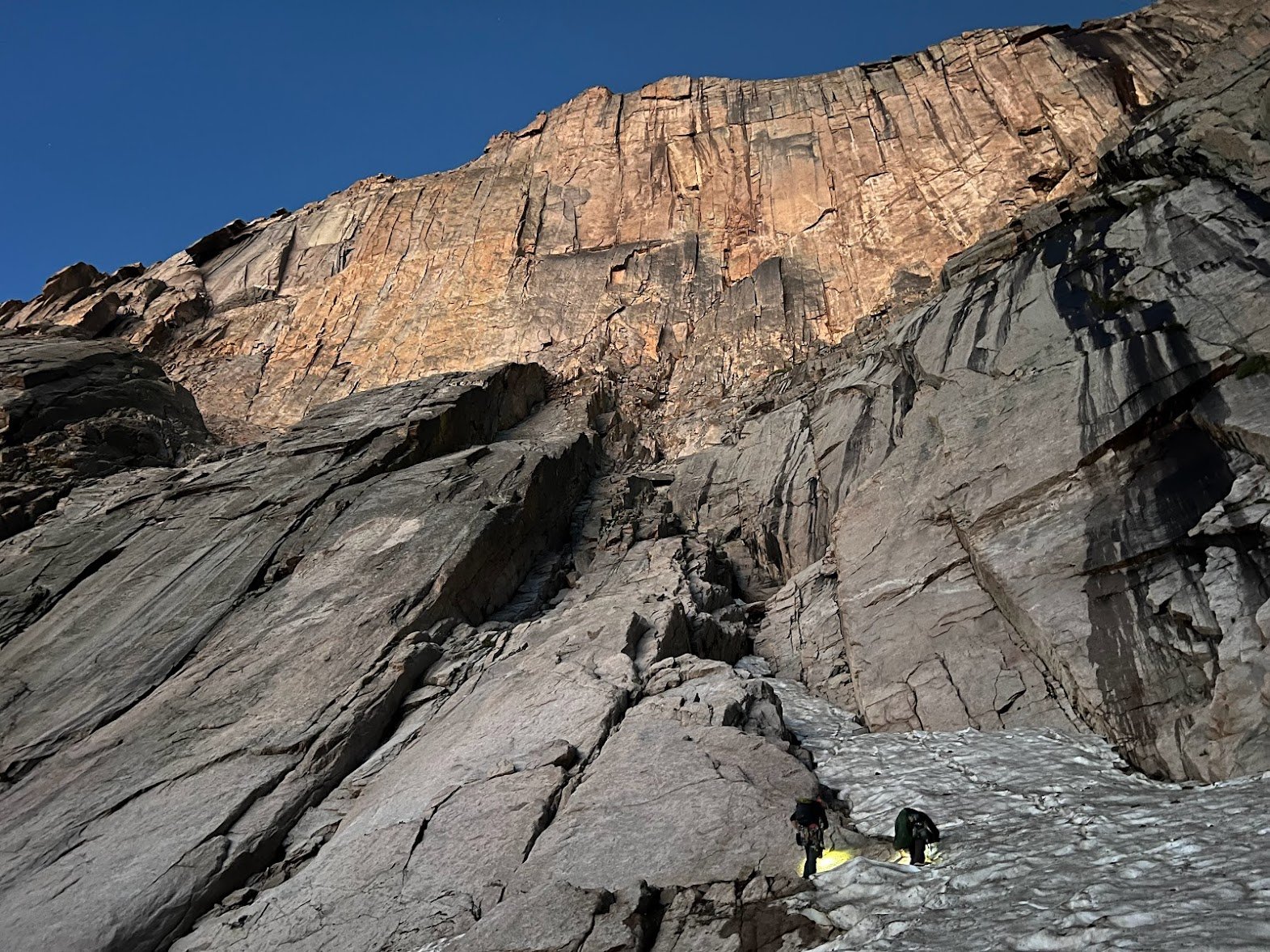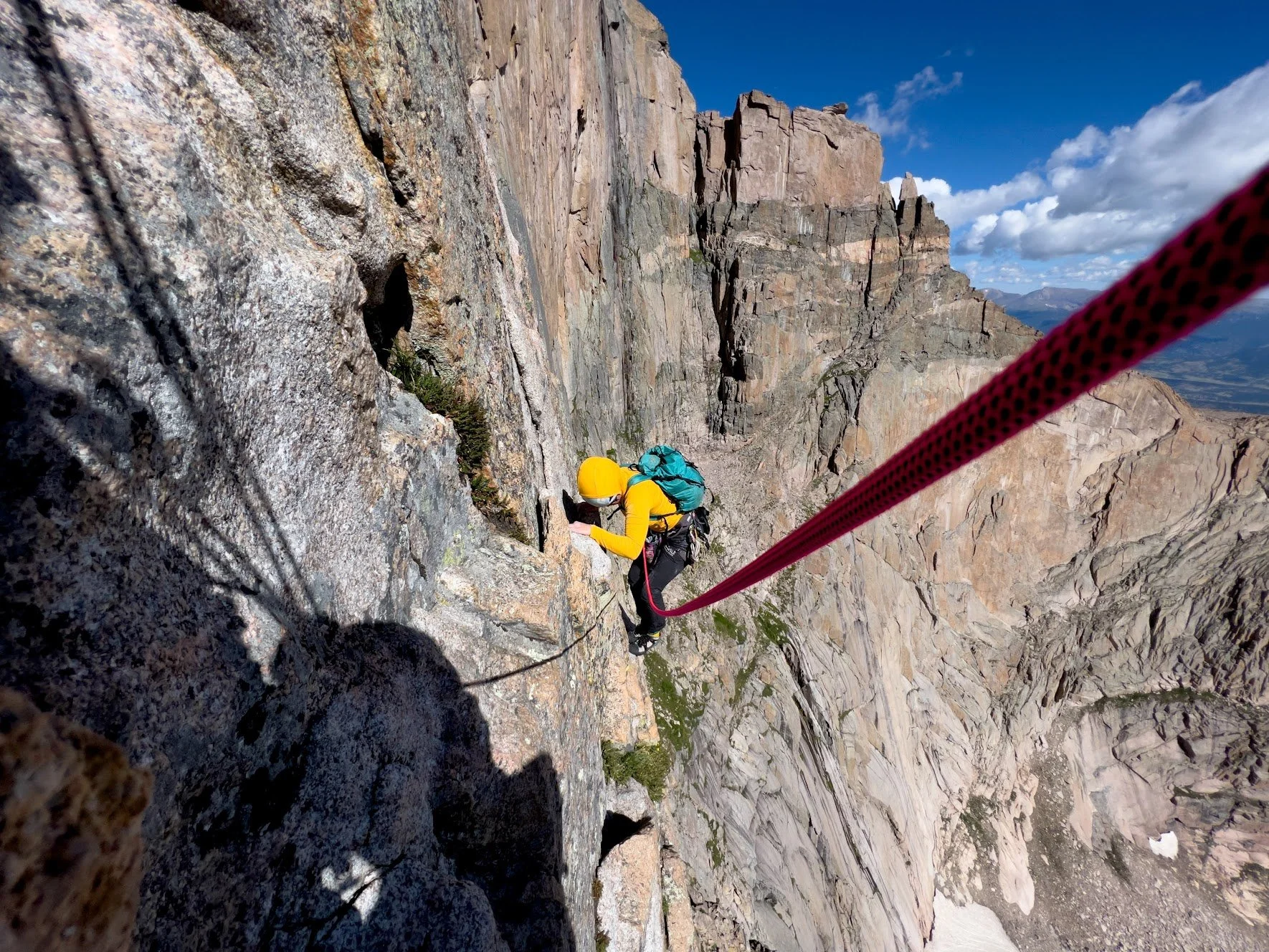
The Diamond’s Casual Route 5.10 V
The Diamond’s
Casual Route 5.10 V
Single:$1350
2 CLIMBERS: $750 /PERSON
Advanced
Rocky Mountain National Park, Colorado
2-Days
There is no place comparable to the alpine rock routes on Longs Peak.
With a million square feet of perfect, vertical granite at 14,000 feet, the Diamond is the motherlode of alpine rock in Rocky Mountain National Park and one of the greatest alpine walls in the world.

-
There is no place comparable to the alpine rock routes on Longs Peak.
With a million square feet of perfect, vertical granite at 14,000 feet, the Diamond is the motherlode of alpine rock in Rocky Mountain National Park and one of the great alpine walls in the world.
The first time you see the Diamond, the sheerest part of the wall- you’ll understand why it draws climbers from all over the globe. It is high, cold, steep, a long way from the parking lot, and most of all, intimidating.
The Casual Route on The Diamond is an iconic route that people from all over the world travel to and climb. Rated at 5.10a, The Casual Route is the easiest on The Diamond, but this does not mean it should be taken for granted.
It feels a full grade harder due to altitude, cold, and daunting exposure. It is a world-class rock climb and is listed as one of the 50 classic climbs of North America. The Casual Route incorporates high-altitude climbing with wild exposure and high alpine weather.
-
Pre Couse Trip Call:
Guides and guests connect via Google Meet to discuss gear selection for the course, meet our new teammates, discuss the climb, and, answer any lingering questions the team has.
Two Day Climb:
We meet in town for a coffee and gear prep at Kind Coffee in Estes. Making sure we have our gear needs met and a dinner plan!
After our gear shakedown, we’ll grab food, head to the Long’s Peak trailhead, and start our hike up to Chasm Junction.
Take a hard left around Mt. Lady Washington to Chasm Lake and make our way into the boulder field.
We will set up camp in one of the large bivy caves around 1 pm and enjoy time in the Longs Peak Cirque.
Dinner around 5 pm with our finds from town!
Morning wake-up starts around 4 am, with the team moving by 5 am towards the North Chimney.
We start our climbing at first light, reaching a quick rest with a view from The Broadway Ledge. Take in the views because the steep climbing starts now! Climb 7 sustained and varied alpine rock pitches, from exposed traverses and tricky corners, to wiggle fests in chimneys and fine unimpeded splitters. Perfect.
From here, we will descend the Diamond Face back towards the ground below.
End Of Day Debrief:
At the cars, we focus our attention on the day; sharing the Rose, the Bud, and the Thorn to ruminate more deeply on the experience. It is often customary ( but not mandatory) to have a meal back in the town to celebrate the great days spent in the mountains!
-
ESTES PARK, COLORADO: GETTING THERE
Estes Park, Colorado is located in the Northeastern part of Colorado and is approximately 45 minutes from Boulder. A mecca for climbing, hiking, cycling, and foodies; make sure you plan to spend some time in town before and after your SMG trip. Estes Park serves as the launching point for all of our climbs in Rocky Mountain National Park.
*If you plan to combine additional days of climbing in Eldorado Canyon or The Flatirons then Boulder, CO is also a logical place to base your lodging for your trip.
The best option for flying to the area is through Denver, CO.
You will likely need to organize a rental car to drive to Estes Park from Denver. Typically in the summer months, you can choose any type of vehicle. Below are some approximate driving times to get to Estes Park, CO.
Denver, CO: 1.5 hours
Boulder, CO: 45 minutes
Colorado Springs, CO: 2.5 hours
Estes Park has many great hotels, suites, and vacation rentals for you to stay in while you’re in the area. Call our office at 410-982-8282 if you have any questions about what would suit you best for this trip! Below are just a few options catering to different lodging styles and preferences.
Boulder, CO also has many great hotels, suites, and vacation rentals for you to stay in while you’re in the area.

-
FOOTWEAR
+3-Season Alpine Bootearly season
+Socks
UPPER LAYERS
+Synthetic T-shirt
BOTTOM LAYERS
GLOVES/HATS
+Buff
BACKPACKS
+45-55L Hike-in Pack
+20L-25L Climbing Pack
ACCESSORIES
+Sunglasses, Sunscreen, Lip Balm, Sun Hat
+Nalgene, Minimum 1.5L
+Climbing Snacks: 100 calories an hour!
CAMPING KIT
EQUIPMENT
+Cramponsearly season
+Light Alpine Toolearly season
+Belay Device w/Locking Carabiner
+3 Additional Locking Carabiners
+120cm Sewn Sling w/ Non-Locker
+Autoblock Cord w/ Non-Locker
Smile Mountain Guides can supply rock climbing gear including helmets, harnesses, ropes, cams, slings, carabiners, belay/rappel devices, ice axes, and crampons. *We do not provide alpine boots
-
BREAKFAST (~300 – 600 CALORIES)
Having a hot breakfast is important, especially in cold weather environments. Most climbers go with instant or quick-cooking hot cereals like oatmeal or Cream of Wheat, or dry cereals and powdered milk mixed with hot water. All of these meals taste better and provide more calories when fortified with dried fruits, nuts, honey, butter, and even chocolate chips! Tastier (and heavier!) breakfast ideas are included below.
For your course, you should have 4 breakfasts. About half of these should be basic meals to decrease weight on the mountain and the remaining can be more luxurious. Don’t forget your hot drinks!
Breakfast Ideas
– 1 cup of granola + freeze-dried fruit + 3 tablespoons of powdered milk mixed with hot water
– 2 packs of instant oatmeal + dried fruit + nut butter
– Dehydrated breakfast meal (check serving and calories)
– 2 packs of instant grits + bacon crumbles + cheese + butter + salt and pepper to taste
– 2-4 powdered eggs + 4-6 strips precooked bacon + tortilla
LUNCH (~800 – 1600 CALORIES) X 2
Lunch begins just after breakfast and ends just before dinner. It is the most important meal of the day and needs to have enough variety to keep you happy over your trip. Continuous eating of small quantities will keep up your energy levels for the whole day, especially on big travel/summit days where we will be on the move for 8 hours or more.
For your course, you need lunch food for 5 days. Determining the amount of lunch food to bring is difficult to gauge on your first mountaineering expedition. General guidelines are given below. The rule many guides work with is the weight of your lunch food should be equivalent to the weight of your breakfast and dinner food added together.
Each day it’s nice to have a “real” food item. You may consider some of these tasty sandwich/wrap combinations:
1. Start with a hearty bread product: flatbread, bagel, naan, flour tortilla, croissant, or pita pocket
2. Add protein: hard cheese, Laughing Cow cheese wedges (no refrigeration needed), cured meat, black beans or hummus, nut butter (we like Trail Butter because it comes in a squeeze pouch), tuna pouch, or smoked salmon
3. Add flavor/texture: dried fruit, chips, hot sauce, mustard, or pesto. Also consider, a hearty pre-made sandwich, leftover pizza, or a burrito for the first day of the course
In addition, pack snack foods to supplement any sandwiches or wraps, such as:
– Nuts (cashew and almonds personal favorite – can buy in 1lb quantities at Trader Joe’s)
– Jerky – beef, turkey, bacon, salmon, and tofu jerky are all great options
– Dried fruit (Trader Joe’s has an excellent selection prepackaged by weight)
– Peanut butter filled pretzel chunks
– Trail mix
– Cheese sticks/squares
– Plantain chips
For summit day or big travel days (approximately 2 on a 3-day course) focus on energy-rich food. On these days we travel for roughly an hour between breaks. At each break, you should be eating 200-300 calories (or about 1 energy bar). These days can have 4-8 breaks. These foods include:
– Energy bars – focus on bars with real ingredients. We love Probars, Pure Organic, Kit’s Organic, Larabar, and Chia Bars. If you are ambitious, try making your own!
– Energy chews (Shot Bloks or the like)
– GU’s, Cliff Shots, etc.
– Candy bars (Snicker’s are a favorite of most climbers)
– Gummy bears
DINNER (~800 – 1200 CALORIES)
For the greatest preparation and cooking ease, freeze-dried food is an option. Usually, these foods only require adding boiling water and are ready within minutes. Downsides to freeze-dried food are the cost, an increase in single-use packaging which must be packed out, uninteresting flavors or textures, gut issues from poorly re-hydrated meals, constipation, etc.
With slightly more effort but vastly reduced cost, any supermarket can be tapped for a wide variety of wilderness-ready prepared foods. Items like Knorr rice or pasta entrees in envelopes cook in 5 to 10 minutes, and are very tasty. It is best if you experiment ahead of time at home so that you know which you prefer. For those with a culinary creative streak, very tasty meals can be made up from scratch with only a minimum of additional effort. Items such as quick brown rice, quick or instant white rice, bulgur, instant precooked or dried beans, dehydrated vegetables, packaged or bulk sauce mixes, smoked salmon, exotic cheeses, and whatever spices and herbs you like or want to experiment with can be combined for tasty meals.
You will need 4 dinners for your course. Many guides bring soup packets, like instant miso soup, for each meal (unless the meal is already soup-based). These make great pre-dinner hot drinks and help us hydrated. Don’t forget your hot drinks!
Dinner Ideas
– 1 packet instant ramen noodle soup + sweet and spicy jerky (shredded) + parmesan cheese + dehydrated vegetables
– 1 pre-pouched Indian Meal (we like Tasty Bites) + boil in the bag rice + coconut oil (vegetarian/vegan depending on meal choice)
– 1 box mac and cheese + sundried tomatoes + tuna packet + red pepper flakes
– 1 box cous cous + sundried tomatoes + pine nuts + chunks of salami
PREPARATIONS TO CLIMB THE CASUAL ROUTE
Technical Experience
Guests should be seasoned multi-pitch climbers with high alpine rock climbing experience before attempting to climb the Casual Route. We require a link-up day in Eldorado Canyon, plus another intermediate alpine rock route, such as The Flying Buttress on Meeker, Kor’s Door on the lower East Face of Longs, or Directissma on Chasm view. These give an idea of what a high alpine rock prep day may look like.
Fitness
Excellent physical fitness is required. Climbers must be able to hike and climb for many hours while carrying a pack. Training for Advanced Alpine Climbing is a great fitness program to develop a strong alpine climbing base.
Meet The Team
FAQ’s
The Diamond’s Casual Route
The answers to our most commonly asked questions about climbing the Casual Route.
-
The Diamond is no joke. If we are serious as a team in climbing the Casual Route as an objective, we need to understand and vett the physical demands of this two day climb.
Being able to climb on the Diamond is a process, enjoy that process.
-
There are very few exceptions for climbing this route in a day with our team and we consider these requests on a guest-by-guest basis.
We have found that climbing The Casual Route over two days is a more enjoyable experience for our guests and guides and there is also significantly more safety margins built into a two day ascent that directly affects success on this route.
*Our price does not change based on a bivy overnight or one day ascent option.
-
PRICE INCLUDES
+Guide fees (2:1 climber-to-guide ratio)
+Park fees
+Group equipment such as ropes, snow and ice protection etc.
+Liquid fuel for white gas stoves (canister fuel is available for purchase)
+Group cook craft items
+SMG Buff
PRICE DOES NOT INCLUDE
+Personal equipment (see Gear List)
+Transportation
+Meals – Part of our ethic is to teach self-sufficiency in the mountains, which includes backcountry cooking. See our suggested Food Plan Below.
+Hotels/lodging in Estes Park
+All expenses incurred in the event of early departure (evac fees, extra hotel nights, etc.)
+Trip cancellation insurance
-
Smile Mountain Guides provides the following gear.
Technical:
+Helmets
+Harness
+Ice Axe
+Crampons
+Ropes
Camping:
+Bivy Bag
+Group Stoves
Smile Mountain Guides does not provide alpine climbing boots for this program, food and personal kitchen items, water bladders, and clothing needed to be comfortable in the mountain environment.
-
Smile focuses on small groups and ratios that meet the professional mountain guiding standard. These programs have a 2:1 ratio and we can accommodate a maximum group size of 4 climbers with 2 guides.
-
Please click here to review our domestic cancellation policy.
-
Yes! This is a custom adventure.















